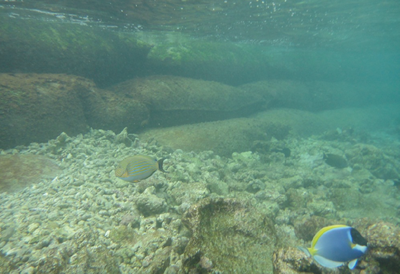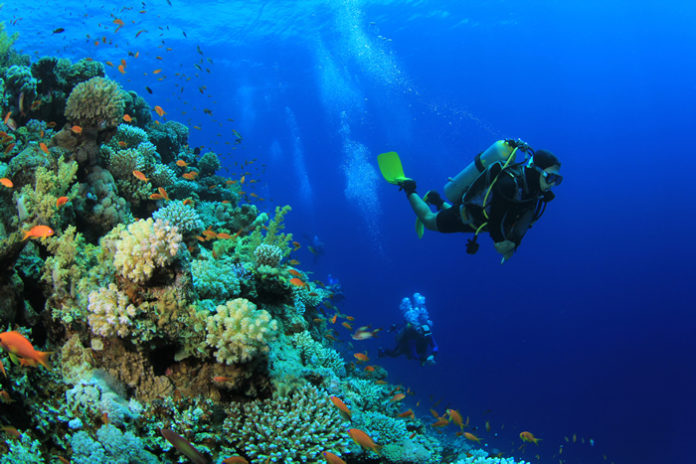After spending a number of years working in Australia’s geosynthetics engineering field, American Joseph Little returned to the States and founded the environmental engineering consultancy firm, Little Environments PLLC in Raleigh, North Carolina. Little brought back considerable insight into the use of geosynthetics in shoreline applications—a major area of engineering in Australia—and a drive to provide, as his website notes: “Little Impact. Big Results.”
While he hasn’t been entirely focused on coastal and inland waterway projects, the sector has certainly stood out in his company’s portfolio. Reef stability and health is an area he has worked to elevate discussion on.
In 2013, Little co-developed what was called the “Waterways to Reefs Initiative,” which sought to add geosynthetics to more reef restoration designs. He wanted to utilize common spoils, such as from dredging and other coastal civil projects, in restoring underwater ecosystems. The designs would give municipalities and states more economical options for dealing with the waste that their waterway activities generated while simultaneously supporting reefs.
“The nature of this dynamic is that Joe has a lot of experience and insight with the use of geosynthetic containers—application and design,” said Cameron Morris, a Florida-based environmental engineer with Coastal Hydrology. “We bring ecosystem restoration and coastal habitat expertise.”
RELATED PODCAST: Improving Waterways and Coasts
Little stressed that the initiative is not about providing standard artificial reefs but stabilizing natural materials like sand and rock to create an “artificially stabilized natural reef.”
“Are we looking just for short-term stabilization until the natural reef can take over and succeed?” Little asked. “Or is something more long term required to truly stabilize it?”
These are questions normally asked of reef restoration and protection, but the solutions have not been too diverse. Little believed this was a mistake.
Though Little Environments provides a deep background in geosynthetics, the company’s engineering approach rejects only one strategy. ”
“You can’t be tied just to geosynthetic containers,” Little said. “You can consider traditional approaches like rock and aggregate too.”
The point is to select an approach that will allow an ecosystem to be restored and to thrive.
THE ROLE OF GEOSYNTHETICS IN NATURAL REEFS
One of the biggest places in which geosynthetic materials can be used in the stabilization of a natural reef is in containing non-stable material. Unstable materials like sediment can disperse back into reefs, thus burying or smoothing out rock formations. This action reduces reef health and diversity by removing the many small spaces in which so many species of plants and animals live.

“In our fishery projects we see how the complexity of reef structure extends the range of species using these habitats,” said Morris. “Nooks and crevices will increase the effectiveness of the habitat itself, what species will utilize it.”
RELATED: An Artificial Island Ringed with Geosynthetics
His company has not previously used geosynthetic approaches such as geocontainers or geotextile tubes, but they see how these structures can promote spaces in which a greater diversity of species may find home.
Geocontainers, constructed of sewn geotextile materials and filled usually with local, on-site soils, have been used widely in Australia for shoreline stabilization, reef security, dune construction, and more.
THE GREATER NEED
Both Little and Morris point out that billions of dollars are spent annually on dredging, shoreline stabilization, opening channels, and beach renourishment. These activities, whether necessary for waterway and shoreline health, navigation, or economic growth, produce an enormous amount of spoils. If they must be transported from site, there is a large cost involved. If they wash back into reef systems, either due to improper storage controls on site or by washing into stormwater and waterway systems from wherever they are dumped, there is the compounded cost of injury to reef systems and the renewed need for the same shoreline or waterway repair work.
“One of the hurdles is getting everyone to sit down and be more open-minded from the outset,” Little said.
He noted that many of the reef-related systems that utilize geosynthetics are somewhat newer (e.g., systems that emerged in 2000, 2010, etc.), but that significant data and information are available.
“It’s more a matter of facilitating a forum of discussion,” he said. “When you get a community involved … you get great results. But you need to include people. You need discussion.”
“I’m an avid diver,” Morris said. “When you build structures, people will want to go to it. They dive, spearfish, etc. You have to inform a community about what you are doing. You don’t want divers shooting spears through your structure. It really takes a community understanding to be good stewards. Treat a reef with respect. Don’t take anything. Don’t break corals.”
“Reef ecosystems,” he added, “are fragile.”
Little and Morris see a combination of traditional habitat restoration techniques and geosynthetic engineering as a way to meet in the middle. They blend aesthetics and performance, environmental and geotechnical engineering. And they see this happening as much on new projects as they do as a solution to piggyback on current waterway and reef projects.
It’s an idea that can be applied effectively at any stage, precisely because of the flexibility of tools available in current design.
For the stabilization of reefs, the beneficial re-use of spoils that are already being generated on a large scale may be a boon to giving government agencies more economical ways to meet multiple environmental goals simultaneously.
“We can turn liabilities into assets,” Little said.
For more information, contact Joe Little at Little Environments, www.littleenvironments.com; and Chris Metcalf at Coastal Hydrology, www.coastalhydrology.com.












